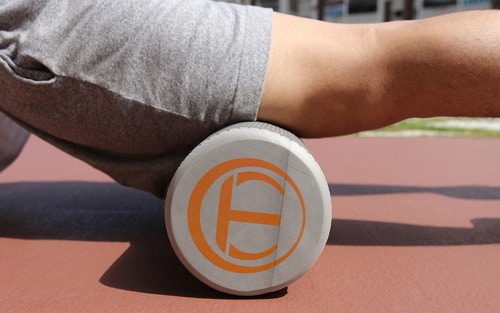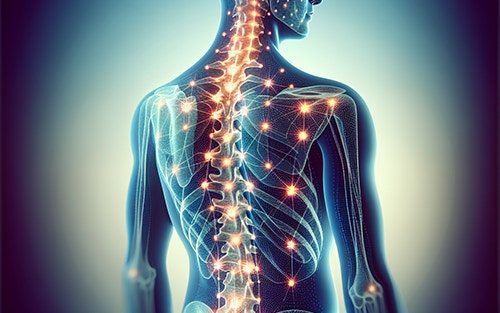Are muscle knots and stiffness hindering your movement? Myofascial release targets the fascia tissue, relieving discomfort and restoring flexibility. In this article, we explain the technique of myofascial release, its effects on the body, and how it can improve your daily life without overstating its benefits.

Key Myofascial Takeaways
- Myofascial Release Therapy targets myofascial tissue restrictions caused by factors like trauma and poor posture, aiming to alleviate discomfort and enhance mobility through applied pressure and manipulation of the fascia.
- Various techniques and tools are used in Myofascial Release, such as manual massage by professionals, self-applied foam rollers, and massage balls for at-home therapy, which help to release fascial tension and improve overall well-being.
- Myofascial Release Therapy benefits a wide range of individuals, including athletes and those with chronic pain or specific health conditions. It can be integrated into wellness routines or combined with other therapeutic practices for better outcomes.
The Science Behind Myofascial Release Therapy
Myofascial Release Therapy is a comprehensive manual therapy method that targets fascial restrictions, primarily focusing on the myofascial tissue. Some common causes of fascial restrictions include:
- Trauma
- Musculoskeletal conditions
- Repetitive stress syndrome
- Poor posture
- These restrictions are known for their knack for hindering mobility and causing discomfort.
The Role of Fascia in the Body

Fascia is a densely woven stringy tissue that offers structural support and safeguards muscles throughout the body. As a network of tissue, fascia links:
- muscles
- joints
- bones
- organs
This provides support and maintains their positioning.
When fascia becomes restricted, it can lead to widespread pain and discomfort, which is where Myofascial Release Therapy comes into play.
How Myofascial Release Works
The essence of Myofascial Release Therapy lies in the application of pressure to release tightness and pain in the myofascial tissues. This pressure triggers the abnormal release of acetylcholine, leading to increased muscle fiber activity.
The applied gentle pressure facilitates a stretch into the restricted fascia, helping to release tightness and alleviate pain.
The Importance of Addressing Myofascial Restrictions
Alleviating discomfort and improving overall well-being necessitates addressing myofascial restrictions. These restrictions refer to the tightness or tension in the fascia, the thin layer of tissue that supports and encases muscles.
Manual techniques involving massaging, kneading, and stretching muscles and fascia directly target and address these restrictions, improving posture and promoting overall wellness.
Techniques and Tools for Myofascial Release
Professionals use manual techniques like gentle, constant massage to release tightness and pain for myofascial release. Various tools, such as foam rollers, tennis or Myo-Release Balls™, and massage sticks, enable individuals to employ various pressures and techniques for releasing fascial tension in a home setting.
Manual Techniques by Professionals
In Myofascial Release Therapy, gentle, sustained pressure is applied to release the fascia using manual techniques. Professionals, such as massage therapists, apply these techniques to loosen and break up scar tissue, thus effectively addressing discomfort and enhancing movement.
Foam Rollers and Their Benefits

In myofascial release, foam rollers prove to be beneficial in numerous ways. Using a foam roller, you can:
- Alleviate muscle tension
- Enhance range of motion
- Promote increased blood circulation
- Facilitate expedited recovery
But remember, utilizing them properly is crucial for effective myofascial release.
Self-Myofascial Release for At-Home Practice
An accessible approach to addressing muscle tightness and discomfort is provided by self-myofascial release. This can be done through:
- Employing manual techniques such as rubbing and massaging the skin
- Incorporating diverse stretching methods
- Utilizing tools like foam rollers or massage balls strategically positioned under targeted body areas
By following these techniques, individuals can manage their fascial tension at home.
Identifying and Treating Myofascial Pain Syndrome
Myofascial Pain Syndrome can be identified by symptoms such as:
- deep, aching pain in a muscle
- persistent or worsening pain
- a tender knot in a muscle
- difficulty sleeping due to pain
To diagnose this condition, muscle palpation is used to identify myofascial trigger points, often referred to as trigger point areas.

These symptoms can then be alleviated using the targeted approach of myofascial therapy, also known as Myofascial Release Therapy or myofascial trigger point therapy.
Symptoms of Myofascial Pain Syndrome
The symptoms of Myofascial Pain Syndrome encompass deep, aching pain in a muscle, persistent or worsening pain, a tender knot in a muscle, localized muscle pain, and trigger points that activate pain. Furthermore, individuals may encounter muscle stiffness, fatigue, and disrupted sleep patterns due to pain.
In some cases, it can even lead to emotional disturbances like depression and irritability.
Diagnosing Myofascial Pain Syndrome
Diagnosing Myofascial Pain Syndrome involves a comprehensive physical examination conducted by a healthcare provider, who will palpate for taut bands of muscles. Trigger points are identified through muscle palpation as areas where the muscle is taut and can produce pain when stimulated.
Treatment with Myofascial Release Therapy
During a typical Myofascial Release Therapy session, gentle techniques are used by the therapist to administer targeted pressure to restricted areas in the fascia. It’s generally recommended to undergo one session per week for the initial four to six weeks to observe improvements, particularly for specific chronic ailments.
Who Can Benefit from Myofascial Release Therapy?
Myofascial release therapy can assist a wide range of individuals experiencing tightness in their fascial tissues, including athletes, individuals with chronic pain, and those suffering from specific health conditions such as migraines and carpal tunnel syndrome.

Athletes and Performance Enhancement
Some benefits athletes can derive from Myofascial Release Therapy include:
- Augmentation of athletic performance
- Enhancement of joint motion
- Restoration of body mechanics
- Alleviation of inflammation
- Boosting circulation
- Improvement of range of motion
All of these elements are essential for competition preparation and injury prevention.
Chronic Pain Management
Myofascial Release Therapy demonstrates a moderate effect in addressing chronic pain, specifically in cases of chronic neck pain. It alleviates chronic pain by:
- Releasing tightness within the fascia through low-load stretches
- Gentle, constant massage
- Addressing the web of connective tissue that can contribute to chronic pain conditions
Specific Health Conditions Treated with Myofascial Release
Myofascial Release Therapy is effective in addressing a variety of health conditions, including:
- Back and neck pain
- Fibromyalgia
- Migraines
- Rehabilitation of stroke patients
It enhances muscle characteristics and function capacity, improves activities of daily living, joint biomechanics, and muscle flexibility, and reduces fascial adhesion.
Integrating Myofascial Release into Your Wellness Routine
Several benefits can be derived from integrating Myofascial Release into your wellness routine. It can:
- Improve joint range of motion
- Reduce muscle soreness
- Facilitate the recovery process, thereby assisting patients in resuming their daily activities
- Complement other therapies such as physical and occupational therapy, massage therapy, and acupuncture, enhancing their effectiveness.
Combining Physical and Occupational Therapy
Combining Myofascial Release with physical therapy allows for addressing various aspects of the body, utilizing a range of techniques to manage pain and dysfunction, leading to improved outcomes in physical therapy.
Similarly, when used in conjunction with Myofascial Release, occupational therapy can enhance occupational performance by implementing a customized treatment plan incorporating Myofascial Release techniques.
Incorporating Massage Therapy and Acupuncture
Both massage therapy and acupuncture can enhance the effectiveness of Myofascial Release. Massage therapy relieves tightness and stiffness, releases pain in myofascial tissues, and reduces sensitivity to pain at tender points.
On the other hand, acupuncture provides immediate pain relief, targets trigger points and promotes relaxation and energy stimulation.
Preparing for Surgery or Sports Competitions
Myofascial Release Therapy can be a game-changer, whether you’re preparing for surgery or a demanding sports competition. It readies the body for the physical stress of surgery, promoting a more seamless post-surgical healing process and diminishing postoperative discomfort.

For athletes, it provides crucial assistance by:
- augmenting athletic performance
- enhancing joint motion
- restoring body mechanics
- alleviating inflammation
- boosting circulation
- improving range of motion
Choosing the Right Therapist
To choose the right therapist for Myofascial Release Therapy, considerations should be made for professionals like physical, massage, and occupational therapists. These professionals should have the necessary qualifications, including advanced training in massage therapy topics and techniques, graduation from an accredited or recognized manual therapy program, and legal practice in their state.
Physical Therapists and Massage Therapists
In Myofascial Release Therapy, physical and massage therapists play significant roles. They are tasked with evaluating, identifying, and treating fascial restrictions using specific techniques to relieve tightness and pain in the myofascial tissues.
Massage therapists apply these techniques to loosen and break up scar tissue, thus effectively addressing discomfort and enhancing movement.
Occupational Therapists and Their Role
In Myofascial Release Therapy, occupational therapists play a complementary role. They aim to enhance musculoskeletal balance, reduce the risk of falls, and improve occupational performance within the scope of traditional occupational therapy.
This involves the application of slow, sustained pressure at the barrier of a restriction to aid in releasing the tension, improving the range of motion, and alleviating pain, thereby benefiting individuals with conditions impacting their occupational performance.
Finding a Certified Myofascial Release Practitioner
Finding a certified Myofascial Release practitioner is important to ensure effective treatment. Recommended methods for locating an accredited practitioner in your area include using reputable websites such as Myofascial Release Directory or Myofascial Release. These platforms offer comprehensive listings of therapists who have undergone seminars and received training from recognized experts in the field.
Myofascial Summary
Myofascial Release Therapy offers a holistic approach to pain relief and improved mobility by targeting fascial restrictions. Not only does it address discomfort and enhance movement, but it also recognizes the significance of fascia in overall well-being. This therapy can be a game-changer for a wide range of individuals, including athletes, individuals with chronic pain, and those suffering from specific health conditions.
By understanding the science behind this therapy, learning about the techniques and tools used, identifying and treating Myofascial Pain Syndrome, determining who can benefit, integrating it into a wellness routine, and choosing the right therapist, you can harness the full potential of Myofascial Release Therapy.
Remember, health is a journey; every step you take toward understanding and addressing your body’s needs brings you closer to optimal well-being. So, are you ready to embark on your journey with Myofascial Release Therapy?
Frequently Asked Questions
What are three myofascial release techniques?
Three common myofascial release techniques are manipulation, traction, and massage. These modalities utilize a combination of traction, compression, and twisting maneuvers to address myofascial tissues.
What does it feel like when fascia releases?
When fascia releases, it can feel deeply relaxing and satisfying for many people, often described as a gratifying pain with a sensation similar to a deep itch being scratched.
Is myofascial release the same as deep tissue massage?
No, myofascial release (MFR) is performed differently from deep tissue massage, focusing on addressing the connective tissue with slow, steady pressure and sustained stretching to release tension.
Can you do a myofascial release on yourself?
Yes, you can perform myofascial release on yourself using tools such as foam rollers and tennis balls, which act as aides for self-massage. These tools can help target muscles and connective tissue for relief.
What are the typical symptoms associated with Myofascial Pain Syndrome?
The typical symptoms of Myofascial Pain Syndrome include deep, aching pain in a muscle, persistent or worsening pain, a tender knot in a muscle, localized muscle pain, and trigger points that activate pain. If you experience these symptoms, seeking medical attention for an accurate diagnosis and appropriate treatment is important.
(706) 521-5290